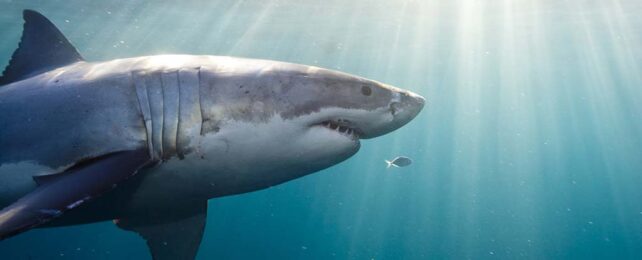We've long thought all great white sharks belonged to a single, global species of long-distance swimmers.
Advances in computing and gene sequencing by an international team of researchers have now revealed groups in the north Pacific, southern Pacific and Indian Ocean, and north Atlantic and Mediterranean are surprisingly distinct.
Separated from each other up to 200,000 years ago during the Penultimate Glacial Period, the three populations of great white shark (Carcharodon carcharias) are no longer kept apart by the land and shallows, yet it seems those barriers live on in practice.
When populations of the same species are physically separated for many generations, each enclave takes on a distinct genetic profile, which with enough time and change can turn one species into several.
Before we developed the technology that allows us to read genes in detail, species were determined largely by attributes we could see with our own eyes, with presumptions that some types could not produce viable offspring with others.
With the advent of genome analyses, we're often presented with a very different picture of who's breeding with who in the natural world.
While the three populations aren't different enough to be considered distinct species quite yet, it's clear they seldom mix genes by interbreeding. The scientists sequenced particular sections of the genes of 89 individual sharks from across the world, and the entire genomes of 17 individuals.
Except for a single shark, each could be placed neatly into just one of the three distinct populations.
This segregation of genes implies great white sharks may be in more trouble than we realized. The loss of any one population would severely reduce the species' overall diversity, removing potentially critical genes that are unlikely to have spread. The overall findings suggest each group relies on a smaller number of sharks to breed with than we thought.
One exception was a 'hybrid' shark, with a mix of Indo-Pacific and North Pacific genes that offer some hope that these populations could bridge their historic differences if necessary.
"If all the white sharks belonged to a single large, integrated global population, it would not matter so much if they vanished from a specific area," says biologist Catherine Jones from the University of Aberdeen.
"It has long been considered that sharks lost from one area would be compensated for with the movement and matings of sharks from other locations."
Their findings, she says, suggests this is unlikely.
"Successful conservation requires recognition of management units, but this has been unavailable for white sharks, which were suspected to exist as a single global population," explains Les Noble, an aquatic bioscientist at Nord University in Norway.
Despite their status as a top predator, great white sharks face many threats, particularly from us humans who have not only hunted and culled the sharks in fallacious quests for revenge, but poached them for food and jaw trophies, yanked them from the water in bycatches, and littered their habitat with junk and harmful chemicals.
If that's not bad enough, now orcas are seemingly on a mission to dent their numbers, too.
"As top predators they play a crucial role in maintaining the health and diversity of local marine ecosystems which are responsible for 20 percent of [the] protein in our diet," Noble says.
"In the last 50 years white shark abundance has almost halved, and it is recognized as critically endangered in Europe."
This research was published in Current Biology.
